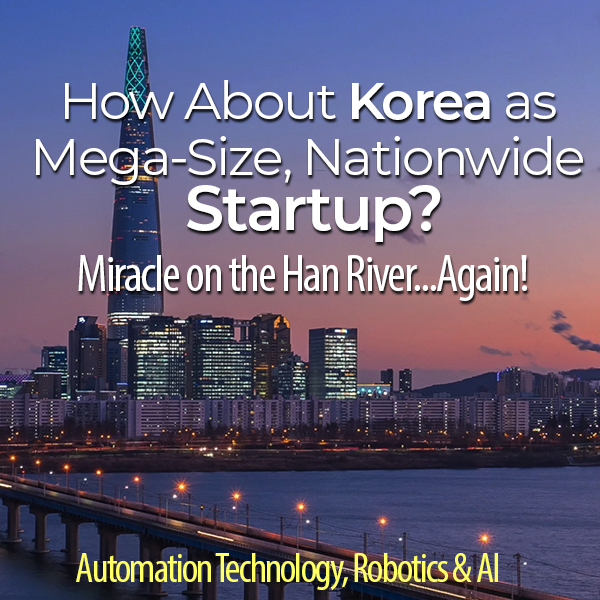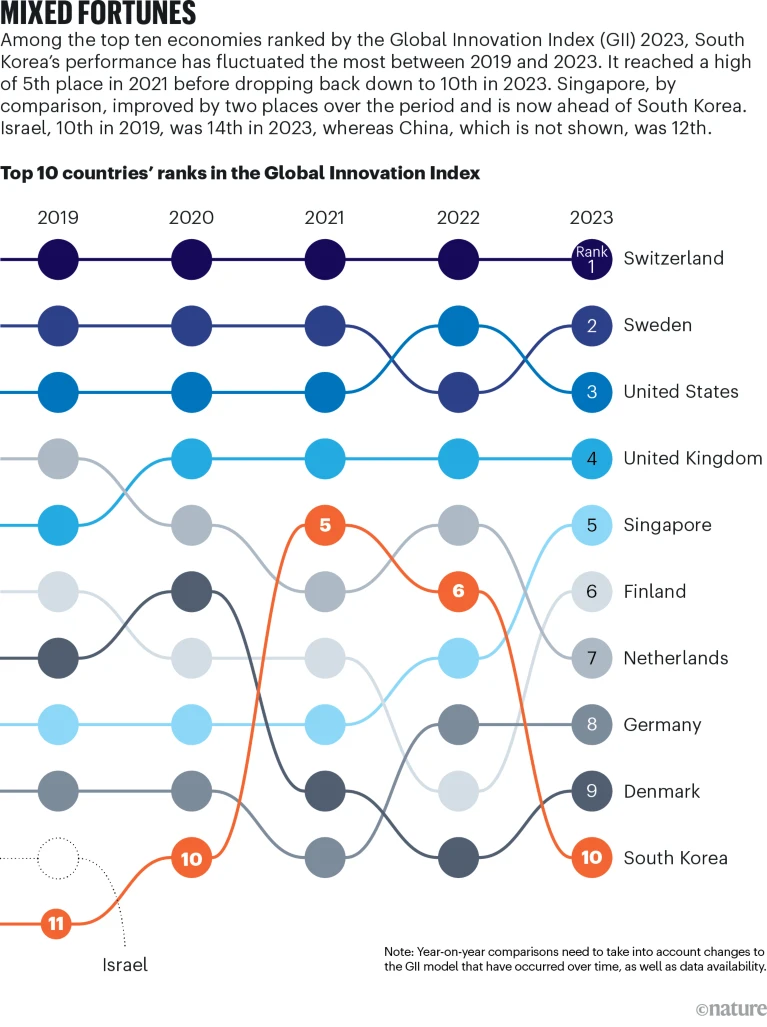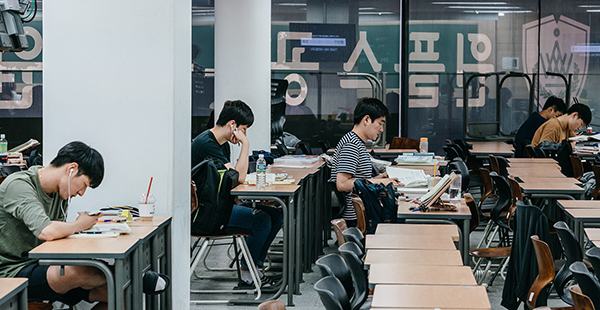
Reclaiming Korea's Innovation
Edge:
Five Key Steps
Korea’s recent slump in world innovation rankings (for the first time falling behind China) is a symptom of a much wider malaise in search of a bold antidote.
Reversing the slump
Peel back the recent slump in innovation, there looking back is also a tragically low birthrate, despondent youth culture, plus worrying data from the World Values Survey showing that Koreans’ belief that they have “freedom of choice and control over their lives” is in decline.
“After four decades of annual growth at a spectacular rate of 6–9 percent, Korea’s annual economic growth has plateaued at 2–3 percent or less since 2012…Korea also has structural vulnerabilities: it relies substantially on one main export product (semiconductors), manufactured by one or two major companies (e.g., Samsung), dependent on a single major market (China), and reliant for critical raw materials on a country with which it is still in a trade war (Japan).”

In response, Korea, with the fourth largest economy in Asia—tenth worldwide—announced, in July of 2020, its National Strategy for a Great Transformation: The Korean New Deal. As then-President Moon commented: “The Korean New Deal will set the foundation for Korea’s next 100 years.”
Moon added: “The government has set a goal of turning the nation’s robotics industry into the fourth-largest player in the world by 2023.” It didn’t happen, together with a few other “didn’t happens”.
What next?
Korea might reverse the innovation slump if it took a daring course of action that involved the entire country, especially if Korea went bold and big enough, which might well be the key to reversing much of what else ails Korea.
Bold and big enough might also ignite fervor among its citizens to support the government effort. The Korean New Deal of 2020 had the scope and enthusiasm of something large and extraordinary and very important to the nation’s well-being.
Maybe what’s needed is to focus on specialized targets, targets that the country does well and are of high visibility, yet in need of more oomph! Automation technology, robotics, and AI catalyzed in an all-out national effort hold great promise for Korea. Why not go all-out on them? And package the trio just as boldly, something like the World’s First Mega Startup in Automation Technology, Robotics, and AI. Something with snap enough to grab world attention and buy-in for the products resulting from the audacious plan.
There’s a formidable high-tech infrastructure already in place to work with. Plus, new areas of economic vitality and interest like that of Seongsu-dong—the “Brooklyn of Seoul”— and the Pangyo Valley, home of Korea’s high-tech startups, and Busan with its IT focus. And let’s not forget Daegu City and Korea’s Robot Technopolis.
If government, academia, startups, and the large business conglomerates (the chaebol) all worked in concert and directed themselves as a unified force, it could well create enough oomph to not only re-elevate the nation’s innovation ranking but also to create a passageway forward for long-lasting national success.
It’s not something new. Korea has already done it once before, which came to be known as The Miracle on the Han River. Does it need another?
Backstory
You’ve got to go back to 1961 to find a comparable effort at a Korean nationwide technology advance. It was tabbed “The Big Push” by the Supreme Council for National Reconstruction (SCNR), and was instituted by the highly controversial Park Chung-Hee, who in 1963 narrowly became president.
Korea in 1961 was in sorry condition. “Korea was by all standards a failed state after the Korean War (1950-53). GDP per capita in South Korea in early 1960’s was below $100. Lower than Haiti, Ethiopia or Yemen, making South Korea one of the poorest countries in the world. Infrastructure built during the Japanese occupation (1910-1945) was destroyed during the war. All of Korea’s natural resources remained in the North, as well as its industrial facilities.”
Korea needed something, and that something came in the form of Park Chung-Hee, and his first Five-Year Plan called “The Big Push”.
“Under Park’s leadership, Korea developed an export-driven model of economic growth wherein special incentives were provided to large business conglomerates (the chaebol) in the form of preferential loans to manufacture goods for sale abroad. Korea’s economy began to take off, regularly achieving double-digit growth rates by the mid-1960s.
That was the impetus to Korea’s rise as an industrial and technology powerhouse. A spectacular feat that is today loosely referred to as The Miracle on the Han River.
The innovation key
“Koreans themselves would tell you that they’re not very good at R&D — even though, from an international perspective, the country is obviously a stellar performer,” said Sung-Young Kim, a political scientist at Macquarie University in Sydney, Australia
Although Korea has fast-tracked itself to success with K-Pop, cinema, fashion, beauty, consumer electronics, automotive, and medicine, Korea’s 30 years of spectacular past successes, are seemingly over.
Korea’s journey to global innovation leadership
Korea’s rise as a global leader in innovation is nothing short of extraordinary, considering its difficult past. For much of the 20th century, the country was a Japanese colony and later ravaged by war.
Yet, in recent decades, Korea has emerged as one of the world’s most innovative nations. Its rapid transformation has been driven by heavy investments in research and development (R&D), collaboration between government, academia, and industry, and a cultural dedication to technological advancement.
However, despite its earlier success, Korea has seen its innovative edge slip in recent years. To regain its position, Korea must address key challenges and reinvigorate its approach to fostering innovation.
Korea’s journey toward becoming an innovation powerhouse began in the 1960s. After the Korean War, the country was one of the world’s poorest nations, with an economy dependent on agriculture and foreign aid. The turning point came under the leadership of President Park Chung-Hee, who implemented a series of Five-Year Economic Development Plans focused on industrialization and technological development. A pivotal moment was the establishment of the Korea Institute of Science and Technology (KIST) in 1966, followed by the Ministry of Science and Technology in 1967.
President Park’s administration encouraged the growth of large industrial conglomerates known as chaebols, such as Samsung, LG, and Hyundai, by protecting them from competition and pushing them to invest heavily in R&D.
With strong government support, these companies expanded into various industries, from shipbuilding and petrochemicals to consumer electronics. This close collaboration between government, industry, and academia created a robust innovation ecosystem that placed Korea at the forefront of technological advancements, particularly in information and communication technologies.
By the 1990s, Korea’s R&D intensity—measured by investment and the number of researchers—was among the highest in the world. Samsung, a key player in this success, evolved from a small trading company into a global leader in electronics and semiconductors, significantly contributing to the nation’s economic output.
Government policies also focused on developing high-tech industries, including semiconductors, broadband infrastructure, and mobile technologies, further cementing Korea’s reputation as a technological leader.
The decline of Korea’s innovation edge
Despite its impressive history, Korea has faced challenges in maintaining its innovative leadership in recent years. According to a 2023 report by Korea’s Ministry of Science and ICT, the country has fallen behind China in several key areas of science and technology development. This was the first time that Korea had been outpaced by its neighbor, signaling a decline in its competitive edge.
Several factors have contributed to this downturn. Firstly, Korea’s reliance on a small group of large corporations [chaebols] has left its innovation ecosystem vulnerable. While companies like Samsung continue to perform well, the country has struggled to nurture a broader base of innovative small to medium-sized enterprises (SMEs) in emerging fields such as biotechnology, artificial intelligence, and renewable energy.
The corporate sector’s dominance in R&D spending—accounting for nearly 80% of total national R&D—has also created a short-term focus on commercial success, potentially stifling long-term fundamental research.
Another issue is the rigidity of Korea’s research funding system. Many R&D programs are short-term and focus heavily on immediate results, which discourages scientists from pursuing groundbreaking, high-risk research.
This has led to a performance-based culture where research output is measured primarily through patents and publications, which can hinder the type of long-term investments needed for breakthrough innovations. Additionally, Korea’s universities remain highly regulated, limiting their autonomy and ability to drive cutting-edge research independently from government priorities.
The country’s demographic challenges are also a cause for concern. Korea has the lowest birth rate in the world, leading to a rapidly aging population. This has shifted the focus of many young Koreans away from science and technology careers and toward more secure and prestigious fields like medicine.

Reclaiming leadership: five key steps
To regain its status as a global innovation leader, Korea needs to address these underlying issues and make significant changes to its innovation policies. Here are five key strategies the country can pursue:
- DIVERSIFY THE INNOVATION ECOSYSTEM: Korea needs to reduce its overreliance on chaebols and foster a more vibrant ecosystem of SMEs, particularly in emerging industries such as biotechnology, artificial intelligence, and green energy. The government should provide greater support to start-ups and small businesses by increasing access to funding and reducing bureaucratic barriers. Creating a more level playing field for innovation will allow smaller firms to thrive and bring fresh ideas to the market.
- ENCOURAGE LONG-TERM, HIGH-RISK RESEARCH: Korea must reform its R&D funding system to support longer-term, high-risk research with the potential for transformative breakthroughs. This means providing researchers with more flexible, multi-year funding options and reducing the pressure to produce immediate commercial results. Countries like Japan have shown that allowing scientists to pursue specific problems over decades can lead to world-changing discoveries, as evidenced by their success in winning Nobel Prizes.
- ENHANCE UNIVERSITY AUTONOMY AND RESEARCH CAPABILITIES: Korea’s universities need more autonomy to set their research agendas and collaborate with international partners. The government should reduce regulatory constraints and allow universities to pursue innovative research without being tied to rigid performance metrics. Strengthening university-industry partnerships will also be crucial in driving the commercialization of academic research and nurturing new technologies.
- ATTRACT AND RETAIN TOP TALENT: Korea must find ways to make careers in science and technology more attractive to young people. This could involve improving the quality of STEM education and increasing government incentives for students to pursue research careers. Additionally, the government should address the concerns of early-career researchers, who often feel disillusioned by the repetitive and manual nature of their lab work. Offering mentorship programs and showcasing role models in science and technology can inspire students to see the value and meaning in pursuing these fields.
- ADAPT TO GLOBAL SUPPLY CHAIN CHALLENGES: The recent disruptions in global supply chains caused by the COVID-19 pandemic, geopolitical tensions, and ongoing conflicts have underscored the importance of building resilience into Korea’s export-driven economy. Korea should continue to invest in strategic sectors like semiconductors, next-generation mobile communications, and renewable energy, while also exploring opportunities to diversify its supply chain and reduce dependence on vulnerable global markets.
National mega startup
By diversifying its innovation ecosystem, encouraging high-risk research, empowering universities, attracting top talent, and adapting to global challenges, Korea can regain its position as a global leader in innovation and continue to shape the technological landscape for years to come.
Seems a new Miracle on the Han River is at hand.
See related:
Major Growth Spurt Ahead for Korean Robotics

